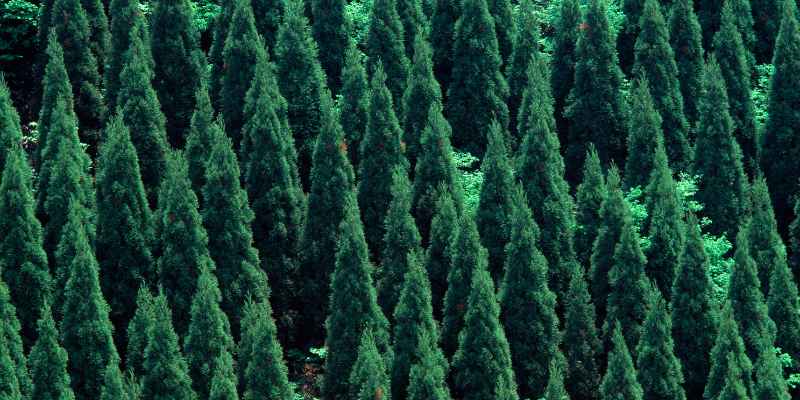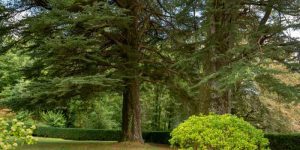The best time to cut cedar trees is during late winter or early spring. This is when sap flow is low, minimizing stress on the tree and promoting faster healing.
Cutting during this time also reduces the risk of insect infestations and diseases that are more prevalent in other seasons. Proper timing is crucial for the health of the cedar tree and to ensure successful regrowth. Planning to cut cedar trees during the optimal season will not only benefit the tree’s overall health but also enhance the quality of the wood harvested.
By understanding the ideal timing for tree cutting, you can maximize the benefits and minimize potential risks associated with the process.
Cedar Tree Basics
When it comes to cedar trees, understanding their life cycle, growth patterns, and species variations is essential for knowing the best time to cut them. Let’s delve into the basics of cedar trees to gain insight into these important factors.
Life Cycle And Growth Patterns
Cedar trees typically have a long life cycle, spanning several decades. They begin as seeds, germinate, and grow into seedlings before maturing into full-grown trees. The growth pattern involves the development of sturdy trunks, branches, and foliage, which contribute to their resilience and longevity.
Species Variations
There are various species of cedar trees, each with unique characteristics that affect their growth and cutting times. For example, Eastern Red Cedar, often found in the eastern United States, has a different growth rate and cutting time compared to Western Red Cedar, which is prevalent in the Pacific Northwest.
Importance Of Timing In Cedar Tree Cutting
Cutting cedar trees at the right time is crucial for their health and growth. The best time to cut cedar trees is during the dormant season in late fall or winter. This timing helps minimize stress on the trees and promotes faster healing and regrowth.
Health And Sustainability
Cutting cedar trees at the right time is crucial for maintaining their health and sustainability. If you cut them during their active growing season, which is typically from late spring to early fall, it can cause stress to the tree. This stress can weaken the tree, making it more susceptible to diseases and pests. Therefore, it is best to cut cedar trees during their dormant season, which is typically from late fall to early spring. This time of year allows the tree to focus on healing rather than growing, which leads to a healthier and more sustainable tree.
Impact On Wood Quality
The timing of cutting cedar trees also affects the quality of the wood. If the tree is cut during its dormant season, the wood will have a higher oil content, making it more resistant to decay and insect damage. Additionally, the wood will have a more uniform color and a straighter grain, making it easier to work with. On the other hand, if the tree is cut during its active growing season, the wood will have a lower oil content, making it more susceptible to decay and insect damage. Moreover, the wood may have an uneven color and a wavy grain, making it more difficult to work with.
In conclusion, the timing of cutting cedar trees is crucial for maintaining their health, sustainability, and wood quality. Therefore, it is essential to cut them during their dormant season, which is typically from late fall to early spring. By doing so, you can ensure that the tree will be healthier, more sustainable, and the wood will have a higher quality.
Optimal Seasons For Cutting
Winter Advantages
In winter, cedar trees are dormant, making it easier to cut them.
Winter cutting helps control pests that may be dormant in the tree.
Summer Considerations
Summer cutting can lead to faster drying of the cedar wood.
Summer cutting may expose the tree to more pests and diseases.
Factors Influencing The Best Time
Factors influencing the best time to cut cedar trees include the tree’s growth stage, weather conditions, and local regulations. It is important to consider these factors to ensure the optimal time for tree cutting, promoting tree health and safety.
Geographical Location
The best time to cut cedar trees can vary based on the geographical location. In regions with milder climates, such as the southern United States, cedar trees can be pruned in late winter or early spring. However, in colder regions, it’s advisable to wait until the late spring or early summer when the risk of frost has passed.
Weather Conditions
The weather plays a crucial role in determining the best time to cut cedar trees. It’s important to avoid pruning during periods of extreme heat or drought, as this can stress the trees. Optimal conditions include a mild, overcast day with temperatures ranging from 45°F to 65°F, which allows the trees to recover more effectively.
By considering the geographical location and weather conditions, you can determine the best time to cut cedar trees for optimal growth and health.
Tools And Preparation For Cutting

When it comes to cutting cedar trees, having the right tools and proper preparation is essential. This ensures the process goes smoothly and safely. In this section, we will discuss the key factors to consider when selecting the right equipment and the necessary safety measures to take.
Selecting The Right Equipment
Before starting the task of cutting cedar trees, it is crucial to gather the appropriate tools. Here are some essential items you will need:
- A chainsaw with a sharp blade and the appropriate size for the tree’s diameter.
- Protective gear, including a hard hat, safety goggles, ear protection, and chainsaw chaps.
- A sturdy ladder or an aerial lift, depending on the height of the tree.
- Rope or straps to secure the ladder or lift in place.
- A pruning saw or loppers for removing smaller branches.
- A wood chipper or a trailer for disposing of the cut branches.
Make sure all your equipment is in good working condition before you begin. Dull blades or faulty machinery can lead to accidents and hinder the cutting process.
Safety Measures
When working with chainsaws and cutting trees, safety should be your top priority. Here are some essential safety measures to follow:
- Wear all the necessary protective gear, including a hard hat, safety goggles, ear protection, and chainsaw chaps, to protect yourself from potential injuries.
- Inspect the area around the tree for any obstacles or hazards that could interfere with the cutting process.
- Clear the work area of debris, rocks, and other objects that could cause tripping or slipping hazards.
- Ensure there is a safe distance between you and any bystanders or nearby structures.
- Always maintain a firm and stable stance while operating the chainsaw or climbing the ladder.
- Follow proper cutting techniques, such as making precise and controlled cuts to avoid accidents.
- Regularly check the chainsaw for any signs of damage or malfunction and promptly address any issues.
- Never work alone. Having a second person present can provide assistance and increase overall safety.
By adhering to these safety measures and using the appropriate equipment, you can ensure a successful and accident-free cutting process.
Environmental Considerations
Consider cutting cedar trees during the dormant season, typically in late fall or winter. This timing minimizes the impact on wildlife and reduces the risk of disease or insect infestation. Additionally, pruning during this period encourages healthy regrowth in the spring.
Cutting cedar trees should consider environmental impacts.
Protecting Wildlife Habitats
Preserve natural habitats for wildlife during tree cutting.
- Avoid cutting during nesting seasons to protect birds.
- Maintain buffer zones to safeguard animal habitats.
Sustainable Harvesting Practices
Adopt sustainable methods to ensure cedar tree longevity.
- Use selective cutting to maintain forest health.
- Replant trees to promote future growth and biodiversity.
Aftercare And Management
For optimal growth, trim cedar trees during late winter or early spring before new growth emerges. Proper aftercare and management post-trimming ensure healthy and thriving cedar trees.
Aftercare and Management is a crucial aspect to consider when cutting cedar trees. Once the trees have been cut down, it is important to take care of the remaining stumps, as well as the surrounding land, to ensure that the area remains healthy and productive. Post-cutting tree care and land management post-harvest are two essential components of aftercare and management that must be addressed.
Post-cutting Tree Care
After cutting down cedar trees, it is important to take care of the remaining stumps. The stumps can be treated with herbicides or removed altogether. Herbicides can be effective in preventing the stumps from regrowing, but they must be used carefully to avoid damaging the surrounding vegetation. Another option is to remove the stumps using a stump grinder or excavator. This will allow for new growth to occur and prevent the stumps from becoming a tripping hazard.
Land Management Post-harvest
After cutting cedar trees, it is important to manage the land to ensure that it remains healthy and productive. This can be done by planting new trees or shrubs, or by allowing natural regeneration to occur. It is also important to monitor the area for invasive species and to control them if necessary. Additionally, soil erosion should be prevented by installing erosion control measures such as mulch or erosion blankets.
In conclusion, aftercare and management are essential components to consider when cutting cedar trees. Post-cutting tree care and land management post-harvest must be addressed to ensure that the area remains healthy and productive. By taking care of the stumps and managing the land, new growth can occur and the area can be maintained for future generations.
Expert Advice And Resources
Cedar trees are a popular choice for landscaping, providing beautiful foliage and a pleasant aroma. However, like all trees, they require maintenance to stay healthy and grow properly. One important aspect of cedar tree care is pruning, but when is the best time to cut cedar trees? In this article, we will explore expert advice and resources for determining the optimal time to prune your cedar trees.
Consulting With Forestry Professionals
One of the best sources of expert advice on tree care is a forestry professional. These professionals have the knowledge and experience to provide guidance on when to prune cedar trees and how to do it properly. They can also advise on other aspects of cedar tree care, such as disease prevention and fertilization.
If you are unsure of when to prune your cedar trees, consider consulting with a local forestry professional. They can assess the health of your trees and provide customized advice on when and how to prune them.
Utilizing Online And Local Resources
In addition to consulting with forestry professionals, there are many online and local resources available to help you determine the best time to cut cedar trees. These resources can provide valuable information on pruning techniques, best practices, and the optimal time of year to prune cedar trees.
Some useful online resources include gardening blogs, horticultural websites, and forums where you can connect with other gardeners and tree care experts. Local resources may include your local extension office, garden center, or botanical garden.
In Conclusion
When it comes to pruning cedar trees, expert advice and resources can help ensure that you are doing it at the optimal time and in the most effective way. Whether you consult with a forestry professional or utilize online and local resources, taking the time to learn about cedar tree care can help ensure that your trees remain healthy and vibrant for years to come.

Frequently Asked Questions
What Is The Ideal Time To Prune Cedar Trees?
The best time to cut cedar trees is during late winter or early spring, before new growth starts. Pruning during this time allows the tree to heal quickly and reduces the risk of disease or pest infestation.
Can Cedar Trees Be Pruned During Summer?
While it’s generally recommended to prune cedar trees in late winter or early spring, light pruning can be done in the summer if necessary. However, avoid heavy pruning during this time as it may stress the tree and make it more susceptible to damage.
Is It Okay To Trim Cedar Trees In The Fall?
It’s generally not recommended to trim cedar trees in the fall. Pruning during this season can stimulate new growth, which is more vulnerable to winter damage. It’s best to wait until late winter or early spring to ensure the tree’s health and longevity.
How Often Should Cedar Trees Be Pruned?
Cedar trees typically require pruning every 3-5 years to maintain their shape and health. However, it’s important to assess the specific needs of your tree and prune accordingly. Regular inspection and pruning can help prevent overgrowth and maintain the overall aesthetics of the tree.
Conclusion
The best time to cut cedar trees is during the dormant season. This typically falls between late fall and early spring. By following this timeline, you can minimize stress on the tree and reduce the risk of disease. Additionally, scheduling tree cutting during this period can also help with the overall health and growth of the cedar trees.


